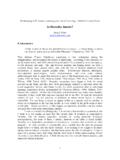Transcription of Re-engineering Indian health care - EY
1 Re-engineering Indian health care Empowered patient (consumer), enhanced outcome and efficient business September 2016. Foreword Disruptive and innovative technologies are revolutionizing how healthcare is delivered today in India and has brought in a tremendous growth to the sector. We have seen a 15 % growth in CAGR for health sector since 2011, which is expected to reach USD 280 billion by 2020. However, providing access to quality healthcare for billion plus population is a huge challenge that the country has to deal with. Our total health spend is only ~ of GDP and out of pocket expenditure (OOP) is 62% of the total health spend. This is very high when compared to other countries such as Brazil 25%, China 32%, South Africa 6%, USA 11%, UK 9%. As India joins many other nations in debating how best to reform the health care sector, it is critical that we engineer these reforms very thoughtfully.
2 This calls for radical improvement of healthcare delivery processes that enhances the quality of care and dramatically lower costs, while also greatly expanding patient accessibility to this improved, more affordable care . We would need a completely new approach for achieving these reforms, which should involve three pillars: people, process, and technology. When these pillars are reengineered, we envision a system of care that is patient-centered, free from cumbersome administrative processes that overcomes inefficiencies, barriers and distractions from the real work of delivering the highest quality of care . This process of Re-engineering Indian Healthcare will need a collaboration between all the stakeholders of the sector, who must innovate beyond their traditional processes to evolve the sector and rise to the challenge of rapid digitization and technology advancement to deliver efficient healthcare.
3 Federation of Indian Chambers of Commerce and Industry (FICCI) as a change agent has been working diligently with the government to bring about requisite policy changes that can provide impetus to the growth of health services sector in reaching out to the masses. This joint study by FICCI and EY evaluates various aspects of Re-engineering our healthcare ecosystem and the role that the government as well as the private sector will play in bringing in this transformation, while keeping the patient at the centre. We are grateful to Ministry of health and Family Welfare, Government of India for supporting FICCI HEAL 2016 on the theme Re-engineering Indian Healthcare on August 31 & September 1, 2016 at FICCI, New Delhi. We are sure that the deliberations in the conference will help us in coming up with concrete recommendations that will be submitted to the Government at the highest level for consideration.
4 Dr Nandakumar Jairam Ashok Kakkar Vishal Bali Chair, Co-Chair, Co-Chair, FICCI health Services Committee & FICCI health Services Committee & FICCI health Services Committee &. Chairman & Group Medical Director, Managing Director, Asia Head - Healthcare Columbia Asia Hospitals India Varian Medical Systems TPG Growth 1 Re-engineering Indian health care : Empowered patient (consumer), enhanced outcome and efficient business Preface In recent years, health care has been a subject of much debate and discussion across the globe more specifically in developed economies, where health care costs are burgeoning. If the current trend continues, these costs are likely to become prohibitive, despite the health needs of significant sections of the populations remaining unmet and disease burden continuing to increase because of longevity and non- communicable diseases.
5 Hence, it is imperative that a new paradigm is evolved in health care policy, program and practice that aims to rationalize costs while expanding access and reducing the need for advanced care . In fact, at a fundamental level, the focus is shifting from sick care to health . care in its true sense. Considering that this is the only solution to the current situation, this trend is expected to continue and strengthen in the times to come. In this context, health outcome, efficient care and health consumerism are the new buzzwords characterizing the emerging health systems, which are being driven by tools and capabilities provided by the digital revolution. India, in terms of healthcare cost and expenditure, is a complete contrast when compared to the developed world, having one of the lowest per capita healthcare spend, total health care cost as a percentage of GDP and cost of health services in the world.
6 Consequently, issues of access and capacity have been a reality for a long time and even affordability has been a challenge for the large majority with meagre means, just enough or struggling for subsistence. However, the context has been changing for the better in recent years and the eEco system seems to be poised for a transformation in the days to come. This report focuses on understanding what will be the key change drivers and what should be the key tenets of the future health system. Interestingly, the deliberations of this report, also find an alignment with the global context discussed above, in terms of the challenges and imperatives facing the country in achieving its agenda of universal health access and right to health . Of course, the specifics of solutions will have to be customized for the local context. It is also pertinent to clarify that in the chapter 2 of the report, related to improving the health outcome, we have not followed a first- principle approach but rather focused on new insights, especially with regard to the potential of technology to change the paradigm of health care and sick care delivery in the country.
7 The key reason for this approach is our belief that several reports in the past, including High Level Expert Group on Universal health Coverage for India, 2011 (HLEG), EY-FICCI reports1, have already addressed the fundamental issues such as that of capacity creation, ramping up human resource for health , distribution of capacity, health financing, in great detail and made robust recommendations for structural and systemic correction. Much of the recommendations are still relevant and also in active consideration by the policy makers for implementation. While some recommendations have already been adopted for implementation, the speed of change can be significantly improved. In addition, we also recognize that the agenda of health outcome will need a broader cross-sectoral approach covering aspects such as nutrition, sanitation, hygiene, water, environment, which are not the focus of this report.
8 We are grateful to FICCI for this opportunity to partner with them on developing this report and the excellent support provided by them in facilitating the discussions with industry stakeholders and providing valuable inputs from time to time. We are also deeply grateful to everyone who gave us time to deliberate on the various aspects of this report and shared their valuable views and insights, which has positively shaped the form and content of this report. It has been an enriching experience for us to work on this report, and we sincerely hope it further strengthens the mood, motivation and mandate for a health system where health care and not just sick care is the core focus. Hitesh Sharma Muralidharan M Nair Sumit Goel Kaivaan Movdawalla Partner, Partner, Executive Director, Director, EY LLP EY LLP EY LLP EY LLP. 1. EY-FICCI Reports: Universal health Cover for India: Evolving a framework for health care reimbursement methodologies , 2013; Universal health Cover for India: Demystifying financing needs , 2012; Fostering Quality care for All , 2008.
9 Re-engineering Indian health care : Empowered patient (consumer), enhanced outcome and efficient business 2. Executive summary Indian health care is a story of great contradictions: it has one As a result, it became a politically irrelevant subject and hence did of the lowest cost health care systems in the world, yet it is not receive priority in allocation of public funds. unaffordable to the large majority of its population. While we The silver lining has been the private sector. Several corporate have institutions and providers, both private and public, that provider chains have emerged in the last two decades with the are comparable to the world's best in secondary, tertiary and ambition, resources and commitment to bring the best-in-class quaternary care , we have a long way to go in providing basic health care to India at one of the lowest costs in the world, even primary care beyond the urban limit where 70% of the population though much of it is restricted to urban areas.
10 Resides. While the Government of the day, during the last decade, has been speaking the language of Right to health and Universal However, the situation is changing and changing rapidly. India health Cover, yet the public expenditure on health at around 1% is no longer a subsistence economy, and with the economic of GDP is one of the lowest in the world. For 16% of the world's transformation witnessed during the last decade, it is steadily population we have a disproportionately high share of global moving on its way to becoming a developed economy; however, at a disease burden at 20% coupled with one of the fastest growing non- per capita level, there is a long way to go. communicable disease incidence. At the same time, we have one Along with it has changed the aspiration and demands of the of the weakest health infrastructures at around beds per 1,000 population in matters of health .
















